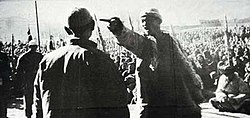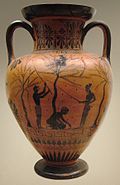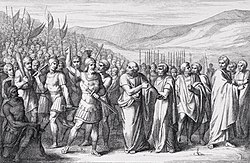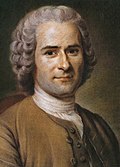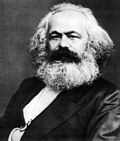Class struggle
| Part of a series on |
| War |
|---|
Class struggle, or class warfare or class conflict, is tension or antagonism in society. It is said to exist because different groups of people have different interests.
Looking at society this way is a feature of Marxism and socialism. Social sciences group people with similar social features into classes. Most of these features are economic.
According to Marxism, there are two main classes of people: The bourgeoisie controls the capital and means of production, and the proletariat provide the labour. Karl Marx and Friedrich Engels say that for most of history, there has been a struggle between those two classes. This struggle is known as class struggle. After The Communist Manifesto and Das Kapital, this concept became well known.
Causes of the Class Struggle
Class struggle happens when the bourgeoisie (the rich) pay the proletariat (the workers) to make things for them to sell. The workers have no say in their pay or what things they make, since they cannot live without a job or money.
Karl Marx saw that the workers had to work without any say in the business. He believed that since the workers make the things, they should say where they go and for how much, instead of the rich owners. They had to work hard to earn a living, while making the rich richer just doing simple office work.
Since they had to earn money to buy food, and jobs were the only things that give money, they had no choice but to work for the rich who made the business. The rich became richer while the worker hauled and lifted and did all of that hard manual stuff no one really likes to do.
Karl Marx thought that their labor limited their freedom by the capitalist exploitation. He wanted the workers to unite and take over the business, so that they could all be prosperous. He thought that the common man deserved to run the business, and that the rich were not better than the commoner.
Forms
Class struggle appeared in some forms. First, there is an economic form. The proletariat struggle with the bourgeoisie through their laborer's organization in this form. Second, there is a political form. In this form, the proletariat has their party and, through democracy, they try to change the system. And the last, there is an ideological struggle. In this form, the proletariat try to adapt the old governing system to new social situations. There are other forms of struggle, too. These forms are not exclusive, but exist at the same time.
History
Class struggle appeared all throughout history. At first, people lived in small communist societies. Then, they took property from the Earth for themselves and started to use slaves. They then had feudalism, which meant one person owned an entire area of land and used soldiers and workers to help them make money, and only gave their workers land, but they had some freedom that slaves didn't. Finally, in Karl Marx's time, people in some countries were becoming workers and bosses during the industrial revolution. The bosses owned the machines that the workers used to make things, but they didn't help using the machines. Instead, they made money by buying the time and energy of the workers to make things. Marx believed that the workers were not making as much money as they deserved because the boss would make money from the work they did without helping.
The future
Marx believed that countries would overthrow capitalism and that workplaces would move toward socialism. This roughly means that the workers would control the workplaces. When this would have happened everywhere, Marx thought the world will have achieved communism.
The Soviet Union overthrew feudalism. They never reached the point of capitalism, so their society was very corrupt. Many blame them for the bad name of communism. There are some workplaces and societies are run democratically by workers, such as the kibbutzim in Israel. [citation needed]
Present day
Social democrats and liberal conservatives do not see society as described by Marx. They see society as changing gradually, through the system of democratic voting. The European Union is composed almost entirely of countries governed by this kind of system, but it is not universal throughout the world. Very few countries have undergone the kind of revolution forecast by Marx. It is much more common for military leaders to seize power and enforce a dictatorship which is neither democratic nor revolutionary.
Class Struggle Media
The Pyramid of Capitalist System, a well-known cartoon satirizing capitalist society.
Truck drivers fight the police in the course of the Minneapolis Teamsters Strike of 1934.
Farmer confronting landlord during China's Land Reform Movement
This 6th century Athenian black-figure urn, in the British Museum, depicts the olive harvest. Many farmers, enslaved for debt, would have worked on large estates for their creditors.
Rousseau by Maurice Quentin de La Tour, 1753
Related pages
Sources
- Karl Marx and Frederick Engels
- Bertell Ollman and Class Struggle Articles on Dialectics Archived 2016-01-10 at the Wayback Machine
- Communist Manifesto (1848)
- Karl Kautsky - The Class Struggle (Erfurt Program) (1888) (contemporary book)
- The Marxists Internet Archive
- Class Struggle and Articles on Dialectics
- Karl Marx - Wage Labour and Capital
- libcom.org - UK-based class struggle resource
- Karl Marx - Capital, Volume One
- Critical Articles on Class Struggle[dead link]



